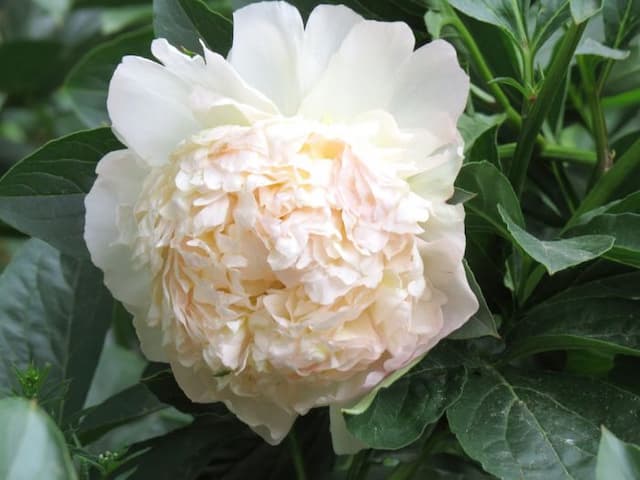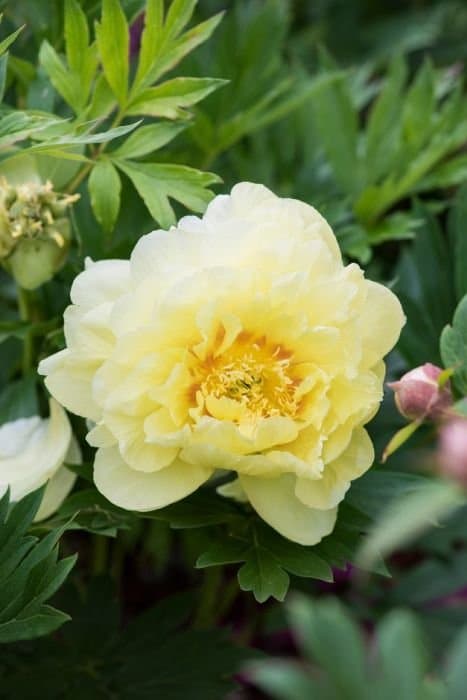Aegean peony Paeonia mascula subsp. russoi

ABOUT
Paeonia mascula subsp. russoi, commonly known as the peony, is a perennial plant that features a lush bush-like growth with deep green, glossy leaves. The foliage is divided into leaflets that are often oblong in shape, giving the plant an attractive, dense appearance that can add texture to any garden space. In spring to early summer, the peony blooms with showy flowers that can capture attention. The flowers are typically large, with multiple layers of delicate petals that can range in color from deep reds to pastel pinks or even whites, depending on the variety. At the center of each flower, there is a cluster of yellow stamens that contrast beautifully against the petals. A single plant can produce several flowers, creating a striking display. After the blooming season, the seeds develop in a cluster of follicles, which, when ripe, open to release the seeds. The peony's overall appearance is one of classic elegance and beauty, contributing both color and form to the landscapes in which it is planted.
About this plant
 Names
NamesFamily
Paeoniaceae
Synonyms
Aeolian Peony, Russo's Peony
Common names
Paeonia russoi, Paeonia mascula var. russoi
 Toxicity
ToxicityTo humans
Peonies, including the variety Paeonia mascula subsp. russoi, are considered mildly toxic to humans if ingested. The roots, seeds, and sometimes the flowers contain compounds like paeonol which can cause gastrointestinal upset, including nausea, vomiting, and diarrhea if consumed in large quantities. Skin contact with peonies can also cause irritation in some individuals. It's advised to avoid ingesting any part of the plant and handle it with care if you have sensitive skin.
To pets
Peonies are also toxic to pets, like cats and dogs, with similar symptoms to those in humans if ingested. The primary concern is gastrointestinal upset, which can include vomiting, diarrhea, and possibly reduced appetite. If a pet consumes a significant amount of the plant, it is important to contact a veterinarian. Although cases of severe poisoning are rare, it is best to keep pets away from peonies to prevent any potential health issues.
 Characteristics
CharacteristicsLife cycle
Perennials
Foliage type
Deciduous
Color of leaves
Green
Flower color
Red
Height
2 feet (0.61 meters)
Spread
2 feet (0.61 meters)
Plant type
Herb
Hardiness zones
7
Native area
Mediterranean
Benefits
 General Benefits
General Benefits- Aesthetic Appeal: Paeonia mascula subsp. russoi, commonly known as the Mediterranean Peony, bears showy, fragrant flowers that enhance the visual appeal of gardens and landscapes.
- Pollinator Attraction: The large, colourful blooms attract bees and other pollinators, supporting local ecosystems and biodiversity.
- Cultural Significance: As a peony variety, it is often associated with various cultural and historical traditions, symbolizing prosperity, honor, and happiness.
- Longevity: Peonies, including the Mediterranean Peony, are known for their longevity, having the ability to thrive and bloom for decades with proper care.
 Medical Properties
Medical Properties- Analgesic: Paeonia mascula subsp. russoi has been used to alleviate pain, particularly in traditional medicine systems.
- Anti-inflammatory: The plant possesses anti-inflammatory properties, which can potentially reduce inflammation and associated conditions.
- Antispasmodic: It may help to ease muscle spasms and convulsions, and it has been used in the treatment of cramps and spasmodic conditions.
 Air-purifying Qualities
Air-purifying QualitiesThis plant is not specifically known for air purifying qualities.
 Other Uses
Other Uses- Fabric Dye: The petals of the Peony can be used to create a natural dye for fabric, offering hues ranging from soft pinks to rich burgundies.
- Scented Sachets: Dried Peony petals can be placed in small bags to create fragrant sachets for drawers and closets.
- Gourmet Garnish: Edible varieties of Peony petals can be used as a delicate garnish on desserts or in salads for an elegant touch.
- Skin Care: Ground Peony petals are sometimes incorporated into homemade facial masks for their natural soothing properties.
- Floral Art: Peony flowers are used extensively in floral arrangements and can be pressed for inclusion in decorative botanical art pieces.
- Garden Compost: Fallen Peony petals and leaves can be added to compost piles to contribute to the nutrient content of garden compost.
- Natural Potpourri: Peony petals, either fresh or dried, can be mixed with other botanical elements to create a visually appealing and aromatic natural potpourri.
- Hair Decor: Fresh or dried Peony flowers can be incorporated into hair accessories, such as hair clips and crowns, for special occasions.
- Biodegradable Confetti: Dried Peony petals can serve as eco-friendly and biodegradable confetti for weddings and celebrations.
- Ink Making: The deep-colored pigment from Peony petals can be employed in the craft of making natural, plant-based inks.
Interesting Facts
 Feng Shui
Feng ShuiThe Peony is not used in Feng Shui practice.
 Zodiac Sign Compitability
Zodiac Sign CompitabilityThe Peony is not used in astrology practice.
 Plant Symbolism
Plant Symbolism- Prosperity: Paeonia mascula subsp. russoi, commonly known as the peony, often symbolizes prosperity due to its full, rounded blooms that resemble coins in some cultures.
- Honor: The peony is associated with honor, especially in Eastern cultures, and is often used in ceremonies and celebrations as a sign of respect and high esteem.
- Romance: With its lush, fragrant flowers, peonies are frequently associated with romance and romantic love, making them popular in wedding bouquets and decorations.
- Beauty: The striking appearance of the peony flower has made it a symbol of beauty in many cultures, representing the ideal of feminine allure and attractiveness.
- Healing: Historically, peonies were used for their medicinal properties, and as such, they can symbolize healing and the wish for good health.
 Water
WaterThe Peony Russo should be watered thoroughly once every 7 to 10 days during the growing season, ensuring the soil is moist but not waterlogged. As a rule of thumb, provide about 1 inch of water weekly, which equates to approximately 0.62 gallons per square foot. During the winter dormancy period, watering should be reduced significantly, as the plant requires less moisture when it's not actively growing. Over-watering can lead to root rot, so it's crucial to check that the top inch of soil is dry before adding more water.
 Light
LightPeony Russo flourishes best in a spot that receives full sun to partial shade. Preferably, it should be placed in an area where it can bask in at least six hours of sunlight each day. However, in hot climates, some afternoon shade is beneficial to prevent scorching of the leaves and flowers.
 Temperature
TemperaturePeony Russo thrives in temperatures ranging between 65°F and 75°F. The plant can tolerate a minimum temperature down to about 40°F and can survive short periods of colder temperatures as long as the ground is not frozen. It's essential to protect the plant from extreme heat and ensure it has winter mulch in regions with cold winters to protect the root system.
 Pruning
PruningPrune Peony Russo after the blooms have faded, usually in late summer or early fall, to remove spent flower heads and encourage healthy growth for the next season. Pruning helps maintain an aesthetically pleasing shape, prevents over-crowding, and enhances air circulation, which reduces the risk of fungal diseases. Every few years, cut back the plant's stems to a few inches above the ground in late fall to prepare for winter dormancy.
 Cleaning
CleaningAs needed
 Soil
SoilThe Peony requires well-draining, fertile soil with a pH of 6.0 to 7.0. A mix of loam, compost, and perlite or sand provides the best balance for drainage and fertility.
 Repotting
RepottingPeonies, including Peony russoi, are long-lived perennials and typically do not need frequent repotting. They should be repotted or divided every 10 to 15 years if they become overcrowded.
 Humidity & Misting
Humidity & MistingPeony russoi prefers moderate humidity levels. High humidity can promote fungal diseases, so ensure good air circulation without excessive moisture.
 Suitable locations
Suitable locationsIndoor
Ensure bright light, cool temps, and regular watering.
Outdoor
Plant in full sun, in fertile, well-drained soil.
Hardiness zone
4-8 USDA
 Life cycle
Life cycleStrawberry peony, or Paeonia mascula subsp. russoi, begins its life cycle when seeds germinate, generally requiring a period of cold stratification to break dormancy. After germination, the seedlings develop into small plants with a rosette of leaves close to the ground. Over the next few years, the plant matures, forming a larger clump with a woody rootstock and multiple stems bearing compound leaves. Flower buds form at the tips of new growth in spring, opening into large, showy flowers—usually red—in late spring to early summer. After pollination, possibly by insects attracted to the flowers’ color and scent, the plant produces follicles containing seeds that mature by late summer. The plant then enters a period of dormancy during the cold months, with the above-ground parts dying back to the ground, while the rootstock survives to sprout again the next spring.
 Propogation
PropogationPropogation time
Spring
Paeonia mascula subsp. russoi, commonly known as Eastern peony, is most effectively propagated through root division. This process is best undertaken in the fall, after the plant has finished flowering and is beginning to go dormant. To propagate by root division, carefully dig up the plant, trying to keep as much of the root system intact as possible. Gently shake off excess soil and use a sharp knife to divide the root clump into sections, ensuring that each section has at least three to five eyes, which are the growth points for new shoots. Replant the divisions immediately, setting them so that the eyes are one to two inches (2.5 to 5 centimeters) below the surface of the soil. Water the new divisions thoroughly to help establish them.






![Peony [Red Sarah Bernhardt]](/_next/image?url=https%3A%2F%2Fplants-admin.emdemapps.com%2Fimages%2Fplants%2F%2Fimages%2F604b5369d170e.png&w=640&q=75)


